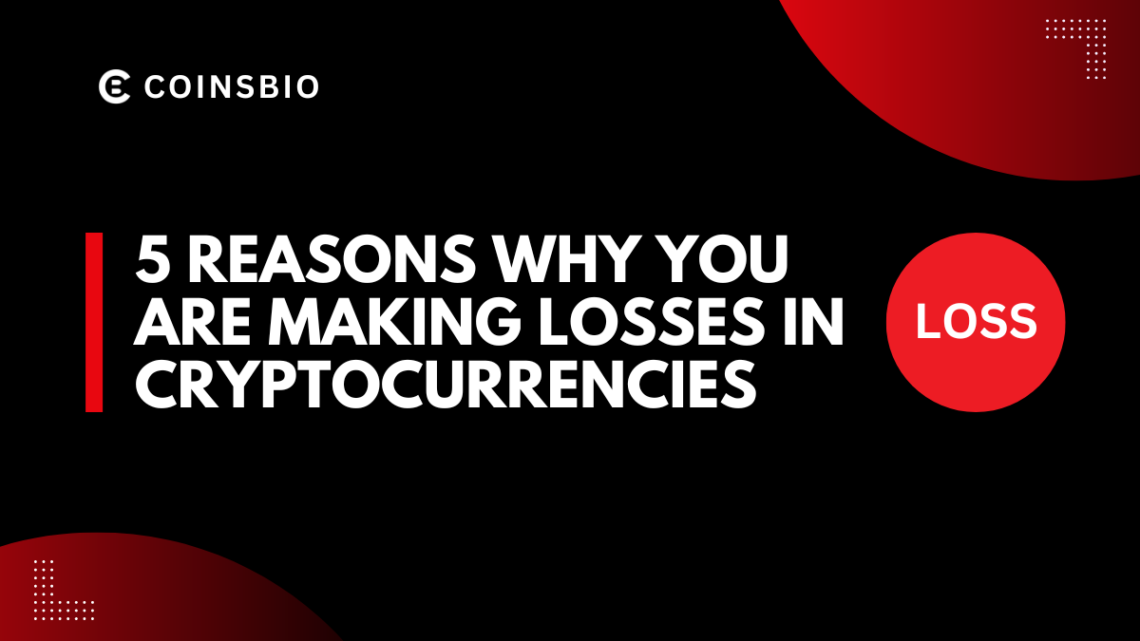Discover why your cryptocurrencies investments are failing as losses: Lack of knowledge, emotional trading, FOMO, and more.
Introduction:
The crypto market glitters with the promise of Lamborghinis and early retirement, but let’s be honest, it can also feel like a casino fueled by rocket emojis and questionable grammar. If your crypto holdings are looking more like a rusty pickup than a sleek sports car, don’t despair!
Table of Contents
- 1 Here are 5 Reasons Why You Are Making Losses in Cryptocurrencies & How to Overtake them:
- 2 1. Lack of Basic Knowledge:
- 3 2. No Stop Loss and Targets:
- 4 3. Buying High & Selling at Low:
- 5 4. FOMO: The Fear of Missing Out
- 6 5. FUD: Don’t Let the Negativity Fest Get You Down
- 7 Bottom Line:
- 8 Frequently Asked Questions:
- 9 I’m new to crypto. What should I learn before investing?
- 10 How can I avoid emotional investing?
- 11 How can I avoid buying high and selling low?
- 12 Everyone’s making money on crypto! Am I missing out?
- 13 What is FOMO (Fear Of Missing Out)?
- 14 What is FUD (Fear, Uncertainty, and Doubt)?
Here are 5 Reasons Why You Are Making Losses in Cryptocurrencies & How to Overtake them:
1. Lack of Basic Knowledge:
A formula for losses is to enter the cryptocurrency market with the confidence of a drunk skydiver. Before diving in, arm yourself with knowledge! This means understanding how different coins function, the underlying technology (blockchain, anyone?), and the crucial distinction between memecoins promising to be the next Dogecoin and established projects with real-world applications.
Beyond coin types and blockchain tech, grasp the crucial distinction between memecoins promising to be the next Dogecoin or Shiba Inu and established projects with real-world applications. Memecoins often rely on hype and social media trends for value, with significant risk of rapid price crashes. Established projects, however, focus on solving real-world problems and have a longer-term vision.
Familiarize yourself with the various trading platforms – both centralized exchanges (CEXs) and Decentralized Exchanges (DEXs) – and their associated fees. CEXs offer a user-friendly experience but may have higher fees and custody risks (you don’t hold the private keys to your coins). DEXs offer greater control but can be more complex to navigate and may have lower liquidity (fewer buyers and sellers).
The good news? A wealth of resources awaits you online and within vibrant crypto communities. Invest some time in learning the ropes – it’ll be your golden ticket to informed decision-making.
2. No Stop Loss and Targets:
Emotions are the archenemy of a sound investment strategy. Resist the urge to throw good money after bad! If a coin’s price plummets faster than your hopes for a tropical getaway, consider cutting your losses and re-evaluating your investment thesis.
Stop-loss orders are your secret weapon in this battle. These nifty tools automatically sell your coins when the price dips below a predefined level, safeguarding you from substantial losses.

Let’s explore an example: Imagine you bought Bitcoin (BTC) at $40,000 with the hope it would reach $100,000. However, the market takes a downturn, and the price drops to $30,000. It could be tempting to hang on in the hopes of a recovery.
But what happens if the cost keeps going down? A stop-loss order set at $25,000 would automatically sell your BTC if the price reaches that level, limiting your loss to $15,000 per coin.
Similarly, setting target prices allows you to secure profits when your investments reach your goals. Continuing with our Bitcoin example, you might set a target sell order at $50,000, locking in a $10,000 profit per coin if the price reaches that level.
3. Buying High & Selling at Low:
This one might seem like a no-brainer, but buying at the peak and panic-selling during market dips is a surefire way to lose money. Develop a well-defined investment strategy and stick to it. Don’t let market volatility pressure you into impulsive decisions.
4. FOMO: The Fear of Missing Out
Witnessing others strike it rich with a random crypto can be tempting, but FOMO (fear of missing out) fueled decisions rarely end well. Stay true to your investment strategy and resist the allure of fleeting trends. Remember, DYOR (Do Your Own Research) – don’t blindly follow social media influencers or self-proclaimed gurus peddling the next “guaranteed moon shot.”
5. FUD: Don’t Let the Negativity Fest Get You Down
The crypto space can be a breeding ground for negativity, often referred to as FUD (Fear, Uncertainty, and Doubt). While healthy skepticism is essential, don’t let the naysayers drown out your research and well-founded beliefs.
Bottom Line:
invest what you can afford to lose, prioritize knowledge, have a strategy, and don’t let your emotions dictate your decisions. With a cool head and a well-informed approach, you can navigate the crypto market with more confidence and avoid the pitfalls that lead to losses. Remember, even the best investors take hits sometimes, but by following these tips, you can stack the odds in your favor and (hopefully) avoid that dreaded feeling of getting rekt.
Frequently Asked Questions:
I’m new to crypto. What should I learn before investing?
Knowledge is power! Before diving in, understand:
Different Coin Types: Utility tokens (access to services), security tokens (ownership of real-world assets), and governance tokens (voting rights in projects).
Blockchain Technology: The secure and transparent system underpinning cryptocurrencies.
Memecoins vs. Established Projects: Memecoins (like Dogecoin) rely on hype, while established projects offer real-world solutions.
Trading Platforms: Centralized Exchanges (CEXs) are user-friendly but have higher fees, while Decentralized Exchanges (DEXs) offer more control but are complex.
How can I avoid emotional investing?
Emotions can cloud judgment. Here’s how to stay cool:
Stop-Loss Orders: These automatically sell your coins if the price falls below a set level, limiting losses.
Target Prices: Lock in profits when your investments reach your goals.
Develop an Investment Strategy: Define your risk tolerance and investment goals. Stick to your plan!
How can I avoid buying high and selling low?
Don’t chase trends or panic-sell during dips. Here are some strategies:
Dollar-Cost Averaging (DCA): Invest a fixed amount at regular intervals, regardless of price. This averages out cost over time.
Technical Analysis: Learn to identify potential entry and exit points based on charts and indicators (use with caution, not a guaranteed method).
Fundamental Analysis: Research the project’s team, technology, and real-world use case.
Everyone’s making money on crypto! Am I missing out?
Don’t fall prey to FOMO (Fear Of Missing Out). Invest what you can afford to lose, and focus on your own strategy. Crypto is volatile, and quick gains can lead to even faster losses.
What is FOMO (Fear Of Missing Out)?
FOMO is a common psychological trap in the crypto market. It’s the feeling of anxiety or panic that you’re missing out on a golden opportunity to make a fortune. This can lead to impulsive investment decisions, often based on hype rather than sound research. Remember, chasing trends fueled by FOMO can result in significant losses.
What is FUD (Fear, Uncertainty, and Doubt)?
UD refers to the spread of negativity and skepticism surrounding cryptocurrencies. This can come from various sources, including news outlets, social media, or even some crypto communities. While healthy skepticism is important, excessive FUD can discourage potential investors from entering the market or cause existing investors to panic-sell. It’s crucial to do your own research (DYOR) and form your own conclusions based on reliable information.

